Research institute:Mint Ventures
overview
overview
This research report mainly focuses on the current development status of the ve(3, 3)Dex project, as well as the commercial advantages and challenges of this model, and further thinks about the long-term development of the Dexs track.
Dexs (decentralized trading platform) and Lending (borrowing) are the first two types of products in the Defi field to achieve PMF (product-market fit), and Dexs, as the infrastructure of the value Internet, has always been the track with the largest number of users and interaction amount , and also the bottom layer of the overall Defi ecology.
Because of this, Dexs has always been the most active field of competition and innovation, and competitors on the same track have maintained a rapid evolution rate in terms of products, economic models, and ecological combinations. The ve(3, 3) mode Dexs proposed by Andre Cronje in early 2022 is just one of the important practices in this field.
This research paper focuses on the topic of ve( 3, 3), and tries to answer the following questions:
ve( 3,3) What is the complete concept? What problems is it trying to solve?
What is the actual business performance of the current representative ve( 3, 3) project? How do they improve upon the original ve( 3, 3 ) mechanism? And what is the valuation level of the project.
ve( 3,3) Will it become a long-term effective Dexs model?
The content of the following report is the author's staged views on the concept of ve(3, 3) and the projects involved as of the time of publication. There may be errors and biases in data, facts and opinions, and they cannot be used as investment reasons. Pointing and correcting.
This article has a lot of content about the ve model, or requires readers to have a preliminary understanding of projects represented by Curve. About Curve, you can read:
Understand the correct posture of Curve: the business status, ecological development, moat and valuation comparison of the top liquidity market(Published February 2023)
CRV under the attack of Uni V3: In-depth analysis of Curve's business model, competition status and current valuation(Published September 2021)
1.ve( 3,3) Definition and value of schema
ve( 3,3) It is not a project name, but a way to build and operate Dex and liquidity agreements. Among them, ve=vote escrowed (voting entrustment), which comes from Curve's ve economic model, and its core advantage lies in the pledge voting mechanism , which further unifies the long-term interests of the participants and the protocol.
And (3, 3) comes from OlympusDAO's (3, 3) game theory (derived from Nash equilibrium theory). Assets such as USDC and ETH make the treasury supported by value assets, and generate OHM and distribute it to OHM pledgers through the Rebase mechanism. If more users enter the market to buy OHM tokens, the treasury will issue more OHM tokens and distribute them to the pledgers, thus creating a positive trend that the pledgers have a high APR when the price of OHM tokens continues to rise. Circular effect, but the premise is that market users do not sell OHM, but choose to continue to pledge tokens, which is the so-called (Stake, Stake)—that is, (3, 3 ). That is to encourage users to continue to participate in the pledge, so as to enjoy the rights and interests of the continuous issuance of OHM tokens, and reduce the risk of token dilution.
If readers find it difficult to understand the (3, 3 ) mechanism, we can abstract it into such a game mechanism:
A project has a network effect, and the larger its multilateral or bilateral scale of users and participation funds, the stronger the barriers to competition, so it has the appeal of continuously expanding its scale to create barriers to network effects.
It introduces a mechanism that extremely encourages all token holders to act in unison to bet on re-investing tokens (or other actions that the protocol expects users to take), which will allow the scale of the protocol to continue to expand, and the network effect will become more and more The more powerful it is, until it forms a strong barrier to competition, enough to obtain the monopoly benefits of the track. As the "shareholder" of the project, as long as the user maintains his share of tokens in the entire project, the value he owns will naturally rise with the expansion of the project's scale and the improvement of monopoly, forming a "win-win" situation.
The vulnerability of this mechanism is that once some users choose to take reverse actions (such as choosing to sell and leave the market instead of staking), the overall expectations and currency prices may gradually resonate, and users begin to withdraw collectively, turning into a spiral of decline , causing the project to fail.
In the stable currency project represented by OHM, the network effect it pursues is that the larger the stable currency network, the more scenarios and users it has, and the harder it is for latecomers to catch up. In the Dex project represented by Solidly, the network effect it pursues lies in the mutual reinforcement of Dex's LP, ve token pledgers and Trader. The larger its share in the trading market, the harder it is for latecomers to catch up. Therefore, the main purpose of the application of the so-called (3, 3) mechanism in the DeFi field is to help projects expand their network effects and build barriers at a specific stage.
In addition to ve and (3, 3), ve(3, 3)'s Dex also superimposes new methods at the project cold start level and the composability of governance credentials. Combining the above designs, it tries to create an overall better Dex model.
Specifically, from the perspective of abstract regression, ve(3, 3) Dex projects have the following characteristics:
The main body of the project adopts Curve's ve economic model, which means:
In addition to being Dex, the project is also a liquidity aggregation and procurement market. The equity token of the project is the liquidity procurement currency of this platform
Project tokens need to be pledged to have governance rights and income (handling fees + bribery) dividend rights. The premise of extracting value from the platform is to be bound to the development of the platform for a long time
The difference between the ve(3, 3) project and Curve is: 1. Curve will distribute all Pool protocol transaction fees to the ve pledgers, while the ve pledgers of the ve(3, 3) project will only get their own votes 2. The LP of the ve(3, 3) project only gets the project token as a market-making reward, and the transaction fee is all owned by the ve pledger; 3. The bribery module of Curve is provided by an external platform (Votium or Votemarket), ve(3, 3) projects have their own bribery module, and short-term procurement liquidity will be easier
Referring to Olympus's (3, 3 ) game mechanism, this means:
Encourage users to stake the project's equity tokens in ve, and provide equivalent token incentives for locked ve certificate holders to avoid dilution of the token ratio of token holders, so as to encourage users active pledge
Through the increase of the pledge rate, the selling pressure of the token is reduced, and the price of the token is promoted. The rise of the token price leads to an increase in the market-making APR, which further attracts more liquidity accumulation and creates a better transaction depth, attracting more transaction volume, forming a self-reinforcing business flywheel
During the cold start, the initial ve certificates are often airdropped to projects with high business and influence in the ecology (often referring to the public chain where the project is located) to recruit the first batch of "B-end customers" for its liquidity procurement market. The logic is similar to that Internet products issue "free experience coupons" to customers, and the experience here is the project's "liquid procurement service"
The pledge certificate of equity tokens has changed from veToken to veNFT. veToken is non-transferable, but veNFT can. This means that users can resell or re-mortgage their ve certificates to further improve capital efficiency
Generally speaking, ve(3, 3) projects are an upgrade of the Curve model, and we hope to focus on the following 3 points:
1. Increase the willingness of users to pledge ve, and further improve the consistency of interests and actions between currency holders and the agreement
2. More "transaction fee" incentive-oriented, because the pool's handling fee is only distributed to those who voted for the pool, which in turn incentivizes transaction volume (better liquidity can attract more transactions to create more handling fees)
3. More "TOB" orientation, which not only provides a better liquidity procurement experience for token issuing project parties, but also higher initial incentives, and actively binds B-side customers
Therefore, the author will also focus on the performance of the ve(3, 3) project in the above three points.
2. ve( 3,3) Representative Item Analysis
secondary title
2.1 Velodrome:ve( 3,3) The first batch of practitioners, OP chain head Dex
Velodrome is the most representative project in the Solidly fork project, and the author will spend more space on it.
2.1.1 Project introduction and difference mechanism
a. Mechanism design
Velodrome is currently only deployed on Ethereum's L2 network OP. Its product mechanism design is derived from Solidly, the originator of ve( 3, 3), but some adjustments have been made, specifically:
Liquidity bribe rewards for Pool, which can only be claimed in the next cycle
The Pool for the incentive issuance of Velo tokens adopts a whitelist mechanism. The whitelist is currently an open application system and does not go through the on-chain governance process. Solidly’s emission application is unlicensed, which means that as long as you have the right to vote, you can Direct token incentives to pools that generate no transaction fees at all. In addition, Velodrome has a committee that can suspend emission of any pool at any time.
The reward ratio for additional issuance of ve token holders has been reduced. Compared with Solidly's guarantee that the proportion of tokens held by ve token holders will not be diluted, under Solidly's mechanism design, the emission rewards of ve tokens are: (Total amount of pledge ÷ total amount of TOKEN) × 0.5 × total incentive emission, and the calculation method of Velo’s additional issuance reward ratio for ve certificates is: (total amount of pledge of veVELO ÷ total amount of VELO) ³ × 0.5 × total incentive emission. Assuming that the current Velo pledge rate is 50%, then under the traditional ve(3, 3) model, veVELO users will get 50% of the total emissions; while under the Velo adjusted model, veVELO users will only get 50%³ = 12.5% of the total emissions, only 1/4 of the traditional model. This improvement has actually significantly weakened the (3, 3 ) part of the ve( 3, 3) mechanism.
3% of Velo emissions will be transferred to the team’s multi-signature wallet as operating expenses, providing a budget for the long-term operation of the project
Canceled the LP Boost mechanism (a mechanism inherited from Curve based on the number of ve tokens that can accelerate LP mining)
b. Team situation
Velodrome Finance was incubated by the team behind the veDAO of the original Fantom ecosystem. And veDAO was incubated by Information Token, an anonymous blockchain research organization. Its initial task is to obtain the governance rights of the Solidy ecosystem proposed by Andre Cronje. At the beginning of 22, Andre Cronje launched Solidly on Fantom, and said that Solidly's initial governance rights (veNFT) will be allocated to the top 20 projects on Fantom according to the ratio of TVL. veDAO was launched along with the trend, attracting nearly $2.6 billion in TVL at its peak.
However, Andre Cronje announced his resignation shortly after, and after Solidly went online, the problems continued to be "overwhelmed" quickly. Since then, the Fantom ecology has also continued to decline in the bear market, and it is no longer as active as it was when AC was located. Since then, the veDAO team has turned to the Optimism ecosystem and developed Velodrome.
c. Milestones and Roadmap
The major events of the project are as follows:
2022.4 veDAO stated that it will launch Velodrome on Optimism using Solidly as a template, and announced that it will conduct a token airdrop.
2022.5 announced that Optimism has become its official launch partner, and Optimism will officially receive veNFT representing approximately 5% of the initial voting power.
2022.6 The product was officially launched and received an airdrop of 4 million OP tokens from OP. 2022.7 TVL surpasses Uniswap (OP chain).
In August 2022, the team wallet was stolen, and operating funds worth 350,000 US dollars were lost. It was later confirmed that the thief was a former team member.
2022.11 Launch the incentive plan "Tour de OP" with a total budget of 4 million OP, which is used to motivate liquidity and veVELO lock users, especially providing high rewards for cooperative agreement projects.
2022.12 Released the function plan of Velo 2.0, which includes the proxy and income optimization functions of ve rights and interests, as well as the basic functions of centralized liquidity, custom Pool, veNFT segmentation and trading, etc. At that time, the evaluation of V2 will be in the first quarter of 2023 roll out.
In February 2023, the VELO FED concept was released, indicating that subsequent veVELO users will be able to adjust Velo's emission rate through governance. In addition, it was announced that Pool's optional fee level (fee level) function will be provided.
2023.2 A new version of the OP incentive plan "Tour de OP" was released, and the incentive ratio for liquidity and veVELO lockup was adjusted.
The next most important milestone for Velodrome is the launch of Velo 2.0, which was originally planned to be released in the first quarter of 2023, but it has not yet been launched as of now (early May 23). The author also inquired about the launch time of Velo 2.0 in the official community. The reply from the community ambassador was that the current audit has been completed and it should be launched in May.
Velo 2.0 contains a lot of content, mainly divided into 5 major parts:
Velodrome "Night Ride" UI upgrade: rich data dashboard, improved interaction friendliness, visual optimization
Velodrome Relay: functions such as optimization of bribery revenue around ve pledge entrustment
New functions: LP customization (basic function of centralized liquidity), Pool customization (editable Pool function like balancer), fee level, voting module upgrade (like Votium), veNFT transactions, fragmentation, etc.
Technology upgrade: code base streamlining, auditing, risk control, etc.
Governance upgrade: veVELO can control the emissions of VELO
However, considering that 2.0 contains a lot of content, the author believes that it is more difficult to launch the functions promised above at the same time, and the possibility of launching them in batches is higher. In addition, functions such as the Lauchpad function, LP automatic reinvestment, complete centralized liquidity function, combination pool (similar to curve's metapool), and veNFT lending are also arranged by the team as key tasks for 23 years.
2.1.2 Business Situation
In terms of business evaluation, the author will evaluate Velodrome and other projects from four aspects, namely: liquidity (TVL) and corresponding liquidity procurement expenses, transaction volume, bribe amount and number of bribe projects, and Velo’s pledge ratio .
As a ve(3, 3) model spot Dex+ liquidity procurement market, Velodrome's business model can be summed up in one sentence, namely: purchase and gather liquidity through the platform equity token (Velo), and then use the liquidity for : 1. Satisfying traders (for exchange fees); 2. Selling to project parties (providing liquidity for their tokens).
Therefore, through the liquidity (TVL) and the corresponding liquidity procurement expenses, transaction volume and handling fees, bribery amount and the number of bribery projects, we can comprehensively grasp the income, customers and cost of the project, while the pledge rate of Velo is used for assessing the (3, 3 ) mechanism effect of the project.
a. Liquidity (TVL) and corresponding liquidity purchase expenses
Data Sources:
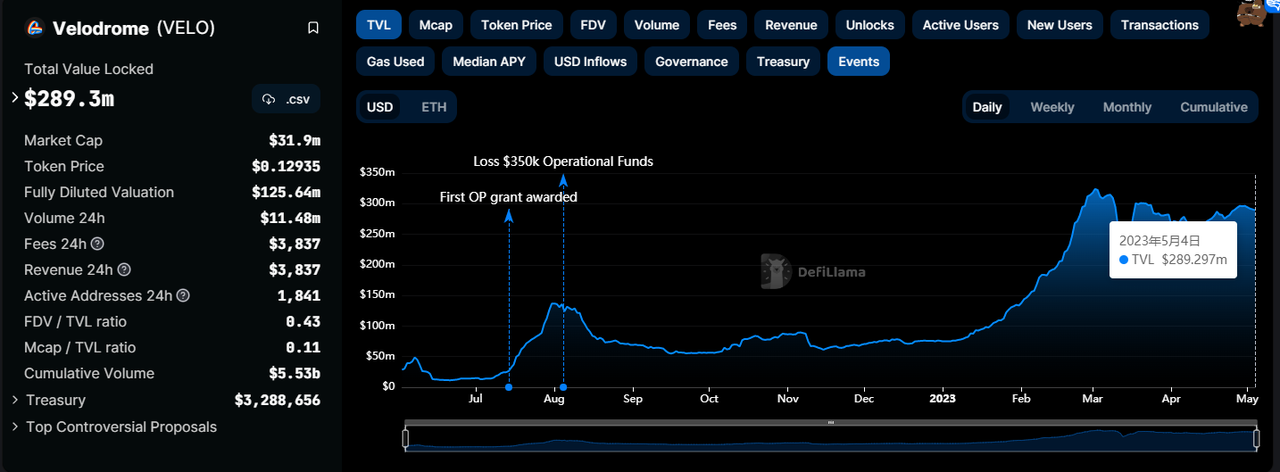
Data Sources:https://defillama.com/protocol/velodrome
image description
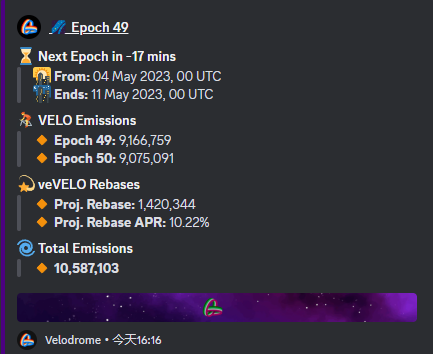
Data source: Velodrome official DC
Then the weekly liquidity incentive is: 9,166,759 × 0.129 = 1,182,511 $. We take the TVL/weekly liquidity incentive, that is, 289, 300, 000/1, 182, 511 = 244.64 $, which we can roughly understand as: Velodrome currently maintains a liquidity of 244.64 $ with an incentive payment of 1 $ per week ( Of course, in addition to the absolute amount of liquidity indicators, there are differences in the composition of its assets and the algorithm of the transaction curve).
b. Transaction volume and transaction fees
Data Sources:
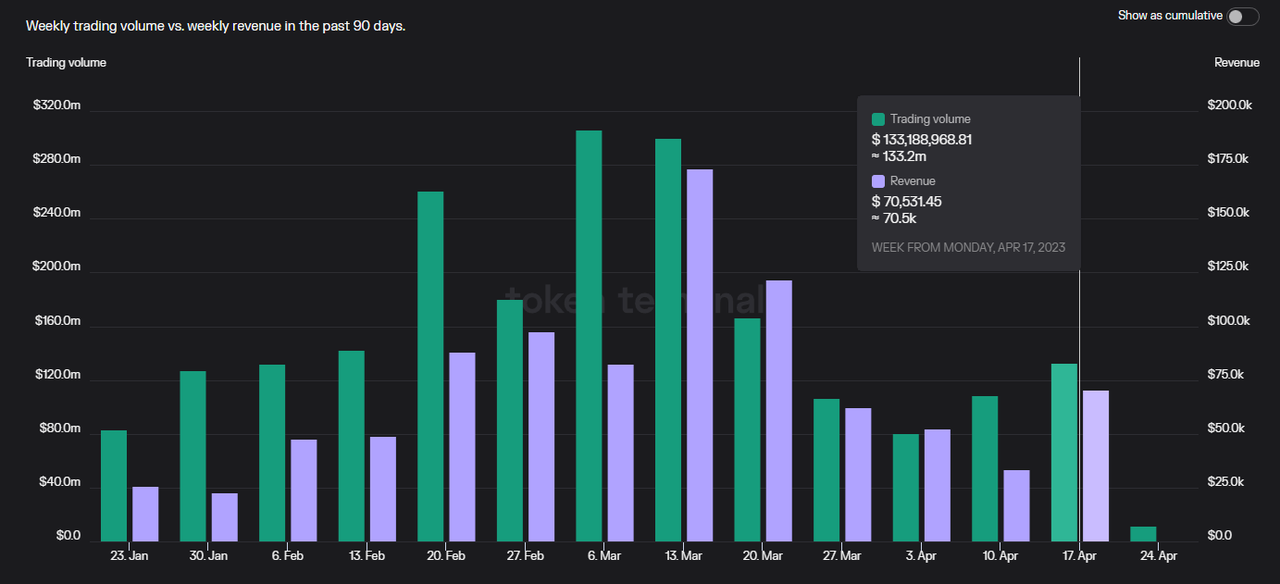
Data Sources:https://defillama.com/dexs/velodrome
And its weekly transaction fee income is between 25,000 and 100,000 US dollars most of the time.
The main source of Velodrome transaction fees is the unstable transaction pair, namely Volatile AMM (vAMM), according to community users@msilb 7 Data Sources:
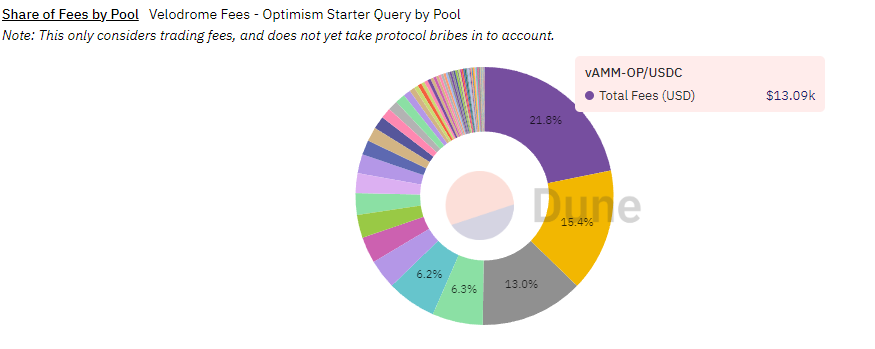
Data Sources:https://dune.com/msilb 7/velodrome-fees
Data Sources:
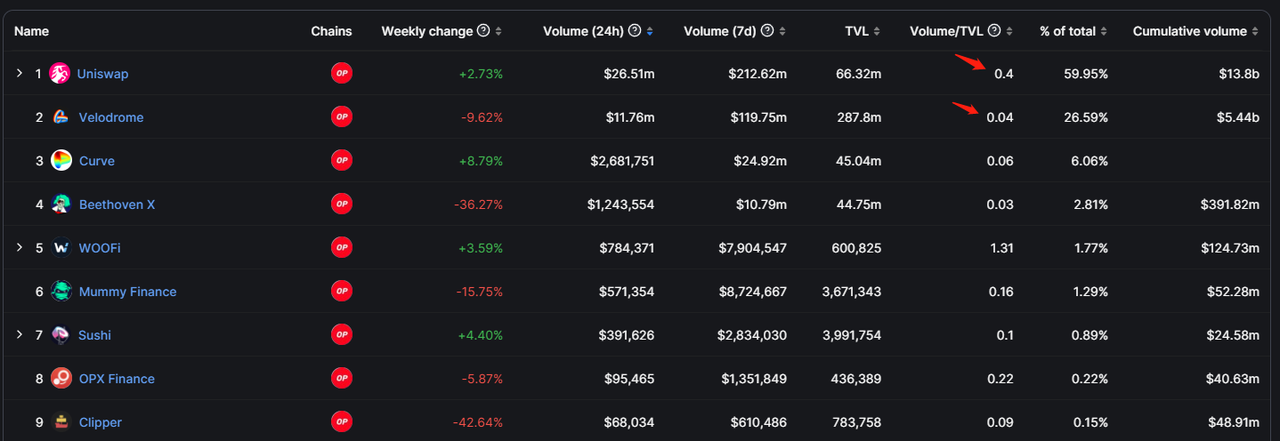
Data Sources:https://defillama.com/dexs/chains/optimism
This huge data difference comes from Uniswap's centralized liquidity mechanism. Although the centralized liquidity mechanism brings higher management difficulties to LPs, it has obvious advantages in capturing transaction volume. This is why Velodrome 2.0 uses centralized liquidity One of the core reasons why sex is a major topic.
c. Bribe Amount and Item Quantity
It is the 49th voting cycle (Epoch 49) of Velodrome at the time of writing, and the total bribes in the previous period were 896,000 US dollars.

Data source: Velodrome DC official channel
Data Sources:

Data Sources:https://dune.com/queries/1454305/2726072
Data Sources:
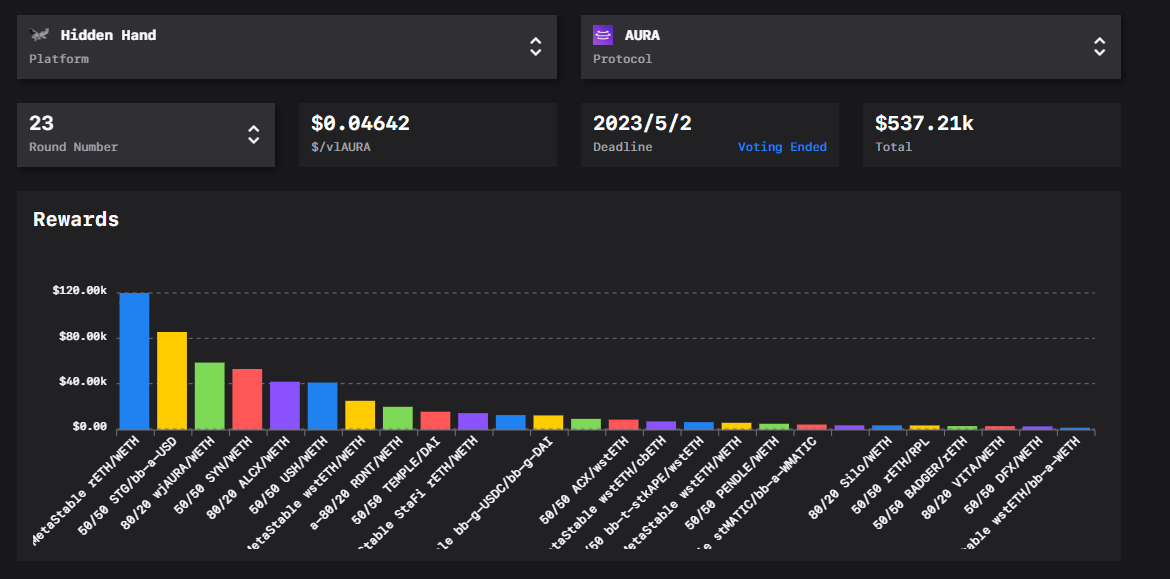
Data Sources:https://llama.airforce/#/bribes/rounds/hh/aura-bal/22
image description

Image credit: Velodrome Medium
According to Velodrome’s bribery data on April 26, there are 248 active pools, among which the top 10 pools with weekly bribes are all above 13,000 $, and there are 49 pools with weekly bribes above 1,000 $.
image description

Image Source:https://app.velodrome.finance/vote
Data Sources:
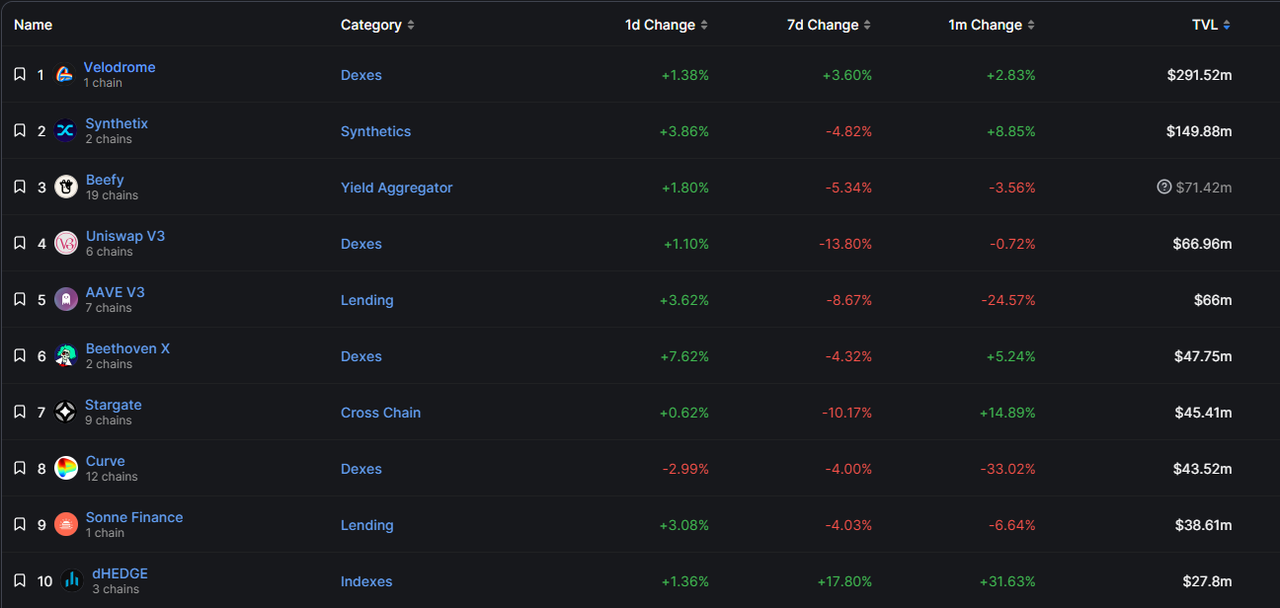
Data Sources:https://defillama.com/chain/Optimism
Overall, Velodrome's liquid procurement customers are rich in sources, highly dispersed, and are in a relatively good development trend.
d. Pledge ratio
Data Sources:

Data Sources:https://dune.com/0x khmer/velodrome-vevelo-leaderboard
image description
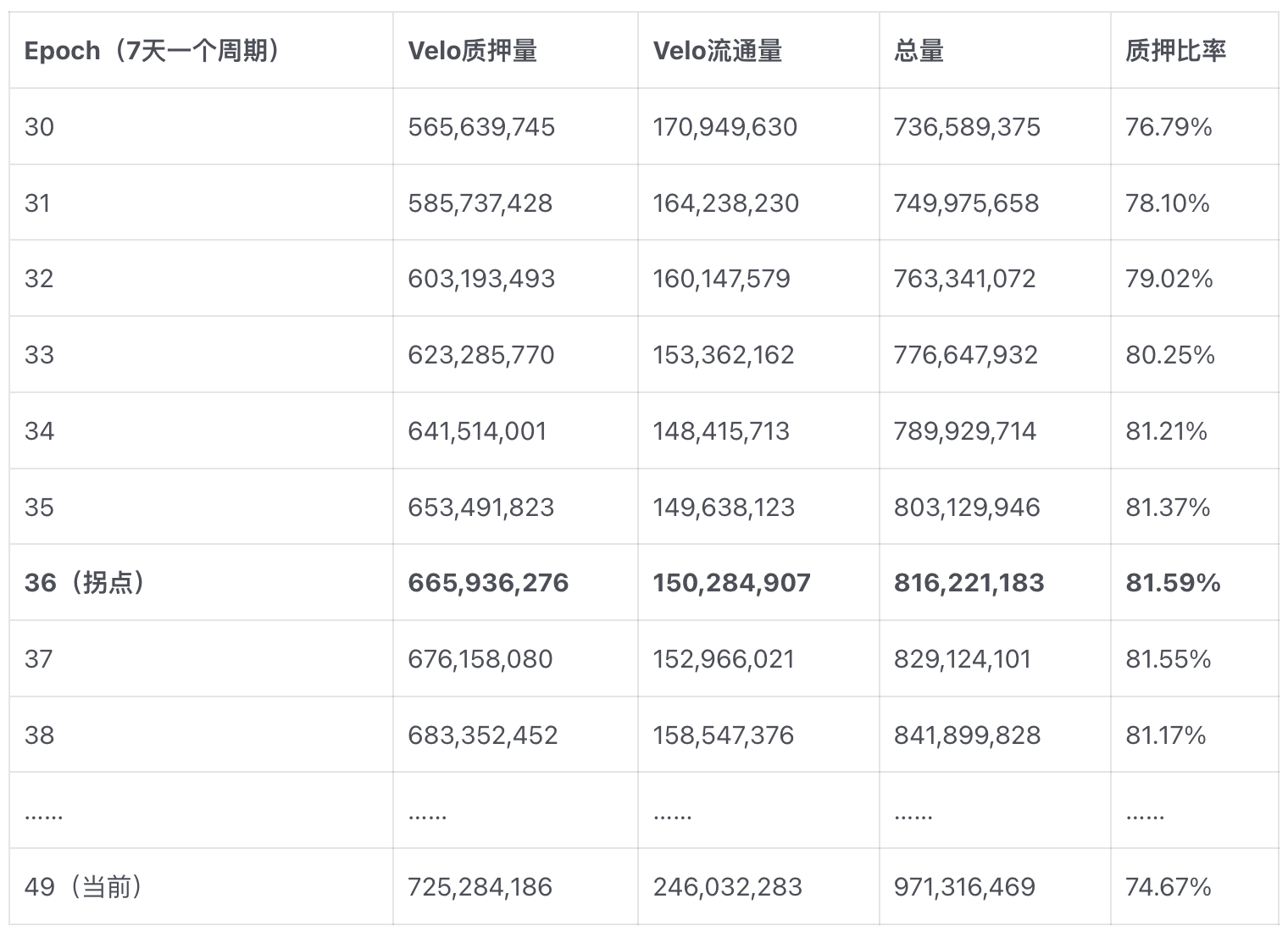
Data source: Dune@0x khmerimage description
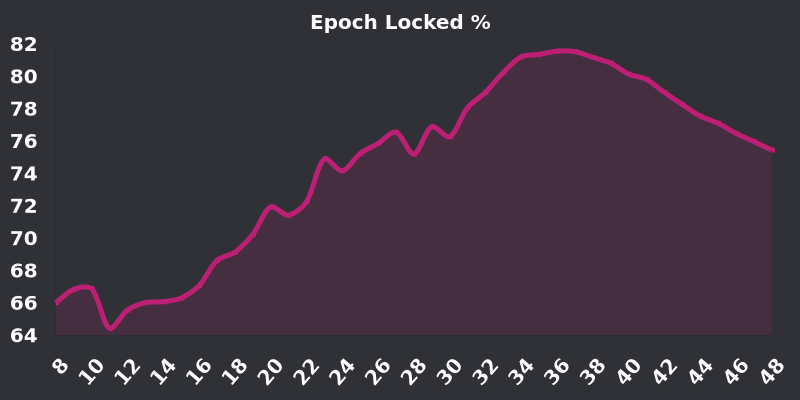
Velo pledge rate curve, image source: Velo official DC
There may be four reasons why the Velo pledge rate has peaked and declined:
image description
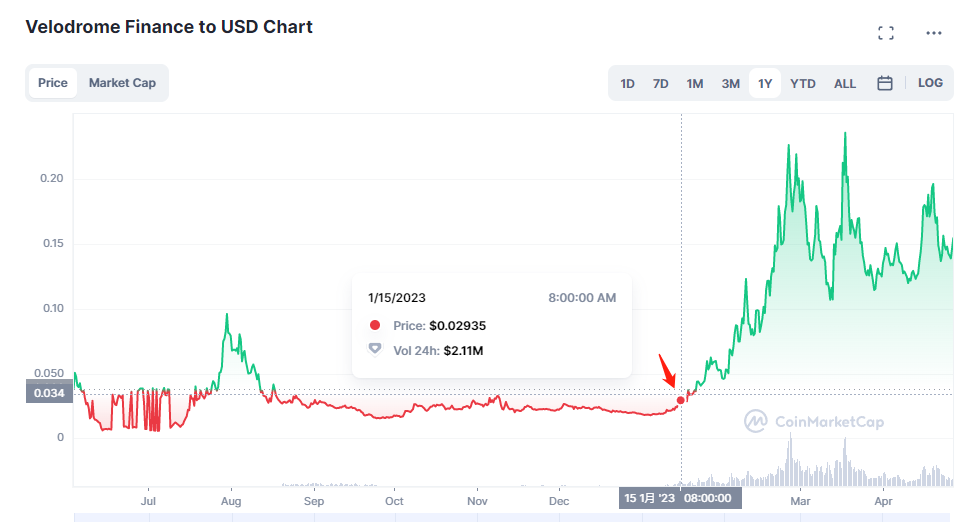
Data source: CoinmarketCap
During the period from February to April, the price of Velo tokens fluctuated violently, with frequent rises and falls of several times, which made investors prefer to hold tokens to maintain better liquidity rather than pledge.
The "Tour de OP" plan, which started in November last year, has lasted for 5 months, and the main content of the plan, which is expected to span from June to August, is that the 4 million OP rewards obtained through Velodrome are used to motivate Velo's lock-up , as the plan comes to an end, the OP’s incentives come to an end, and the incentives for locking positions will further decline, forming a potential selling pressure.
70% -80% is already a very high lock-up rate, and the comprehensive marginal cost of maintaining and improving the lock-up rate is getting higher and higher. Curve, which also adopts the ve model, currently has a pledge rate of 38.8%.
2.1.3 Summary
secondary title
2.2 Thena: The centralized liquidity ve( 3, 3) leader on BNBchain
Thena was launched in January this year. Currently, TVL ranks 9th on BNBchain, and it is also the first ve(3, 3)Dex to realize the centralized liquidity function.
2.2.1 Project introduction and difference mechanism
a. Mechanism design
Thena is currently only deployed on BNBchain, and it has further modified ve(3, 3) on the basis of Velodrome. The important mechanism changes include:
At present, the centralized liquidity function called Fusion has been launched, and it supports the automatic market-making interval management strategy based on centralized liquidity
The rebase reward of ve tokens accounts for 30% of each output (it is the upper limit and is also the current fixed value)
Introduce the recommendation mechanism, the recommender can share the transaction fee of the new user, and the new user will have a lottery reward through the recommendation
Early adoption of NFT for fundraising, after NFT is pledged, can share 10-20% of the agreement's handling fee
Increased fees to 0.02% for sAMM pools and 0.2% for vAMM pools (0.01% and 0.05% for Velodrome)
In addition, Thena, like Velodrome, adopts the Gauge application permit system, cancels LP boost, and gives 2.5% of each emission token (Velodome is 3%) to the project party.
Fusion: Centralized Liquidity + Automation = Lower Barriers to Participation and Capital Efficiency
In addition to the overall mechanism design of the project, it is necessary to focus on the Fusion function launched by Thena in April. This is the biggest feature that distinguishes Thena from other ve( 3, 3) projects, and it is also the core function of Thena V2.
The main functions of Fusion are as follows:
Introduce the centralized liquidity (CLMM) capability, allowing LPs to customize the market-making range. The advantage is that the same capital is concentrated in a range, so it can provide a thicker depth and lower slippage in [a specific price range], so it can capture greater transaction volume and handling fees, thereby increasing LP in [ Capital efficiency within this range. The reason why [within a specific price range] is repeatedly emphasized is because once the asset pair of LP market-making breaks through this price range, the asset pair will be converted into a single asset, and the handling fee can no longer be captured (at this time, the capital efficiency is 0 ), and this process means a higher risk of impermanent loss. Therefore, under the centralized liquidity mechanism, market makers need to have a higher level of market making (prediction of price trends, energy and strategies for dynamically adjusting market-making intervals) ) to match.
image description
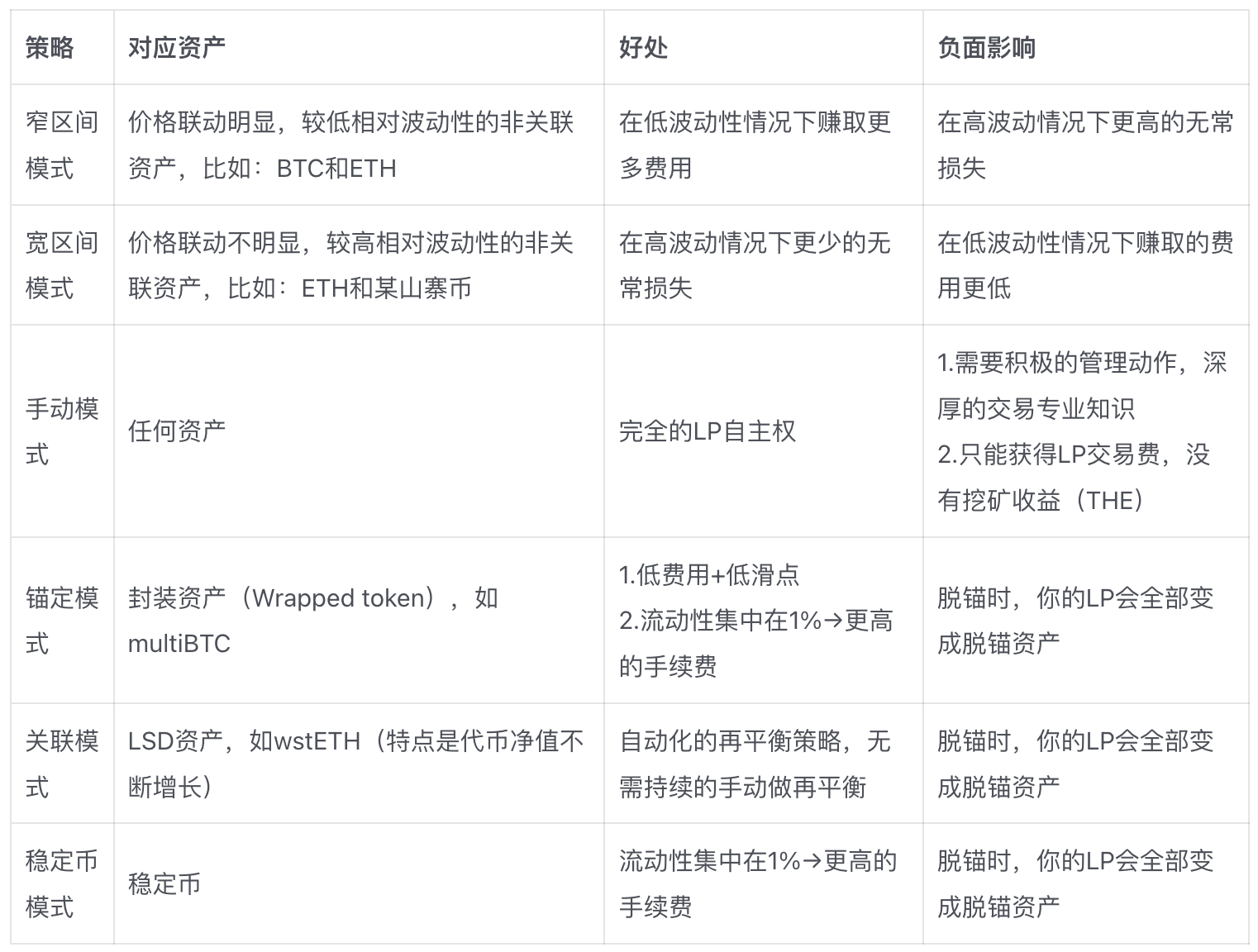
Source: Thena Official Medium, tabulation & translation: Mint Ventures
Introducing a dynamic fee model. As the price change range of assets in the pool increases, the fee ratio increases (to subsidize the impermanent loss of LP); when the price change narrows, the fee decreases to capture more transaction volume.
Overall, Fusion brings obvious benefits to Thena, especially simplifying the complexities of market making based on centralized liquidity. But as mentioned above, the market-making challenge under the centralized liquidity mechanism requires not only continuous adjustment of the market-making range, but more importantly, predicting the price trend (is it fluctuating or unilateral? Is it a wide fluctuation or a narrow fluctuation?), this It is a problem that automated strategies cannot help users solve, and it is also a risk that users must bear.
In addition, Fusion's centralized liquidity mechanism and dynamic fees come from Algebra Protocol's services, while automated LP management uses Gamma's services (LPs do not need to pay for using Gamma's services, and Thena provides Gamma with veTHE as a reward). The innovative approach allows Fusion to go online faster (while the centralized liquidity module that Velodrome has been developing for several months has not yet been released), but on the other hand, since Fusion's core services come from a combination of three parties, it also introduces more external risks.
b. Team situation
The Thena team currently does not disclose real name information, and its main members come from Liquid driver, a revenue aggregation and liquidity service project on Fantom. Previously, Liquid driver formed 0xDAO with SpookySwap, Scream, Hundred Finance and RevenantFinance, which belong to Fantom, and adopted a platform similar to veDAO The model absorbs liquidity, and finally raised a liquidity of 2 billion US dollars at the peak period, and also obtained the largest proportion of ve airdrop shares in the follow-up Solidly.
At present, the business of the Liquid driver project itself has been relatively sluggish. The TVL is only about 8 million U.S. dollars, and the token FDV is only about 17 million U.S. dollars. It is expected that the team is currently focusing more on Thena. However, although the Thena team has not disclosed the core member information at present, many members in the community said that they "know who they are", so the team is not strictly anonymous. Also according to the information provided by community members, Thena’s core team has 8 members, which is a relatively capable team.
c. Milestones and Roadmap
The major events of the project are as follows:
Time event 2022.10 project official announcement, introducing the concept of Thena and the follow-up NFT financing plan.
2022.11 Release NFT financing details and financing time, a total of 3,000 founding NFTs, and the cost of a single mint is 2-2.5 BNB.
2022.11 Release THE token economic model.
2022.12 NFT sale completed.
2023.1 Thena was officially launched, and the TVL exceeded 100 million US dollars in the same month. 2023.2 Launch the transaction recommendation system, using the services of MUON.
2023.3 Official announcement of the Fusion function.
2023.4 The Fusion function is launched.
2.2.2 Business Situation
a. Liquidity (TVL) and corresponding liquidity purchase expenses
Data Sources:

Data Sources:https://defillama.com/protocol/thena
Similar to Velodrome, the Thena platform's liquidity purchase expenditure is the emission incentive for The Pool. Currently (epoch 17) Thena's total weekly emission is 2,213,790 (according to official documents, the initial weekly emission is 2.6 M, and the subsequent Decrease 1% per week), of which the emission used for liquidity incentives accounts for 67.5%, and the unit price of THE is 0.33 $, that is, the incentive used for liquidity purchases is 1,494,308 × 0.33 = 493,121 $, we use Liquidity divided by weekly liquidity incentive: 81,410,000/493,121 = 165.1 $. We can roughly understand it as: Thena was able to maintain a liquidity worth 165.1 $ through a weekly incentive payment of 1 $.
b. Transaction volume and transaction fees
image description

image descriptionhttps://defillama.com/protocol/thena

Handling fee, data source:https://defillama.com/protocol/thena
And its weekly transaction fee income is between 40,000 and 100,000 US dollars most of the time. Compared with Velodrome, Thena's transaction volume is lower, but overall it creates higher transaction fee income. The main reason is that its V1 version of vAMM and sAMM has a higher transaction fee ratio, vAMM is 0.2% (Velo is 0.05 %), sAMM is 0.04% (Velo is 0.01%).
It is worth noting that after the launch of Fusion, both the transaction volume and handling fees generated by it have rapidly increased in the proportion of Thena's total business, especially handling fees, which have already accounted for 73.8%. More importantly, this is still generated when Thena TVL declines. Fusion's centralized liquidity + dynamic handling fee can capture the transaction volume and handling fee.
c. Bribe Amount and Item Quantity
Data Sources:
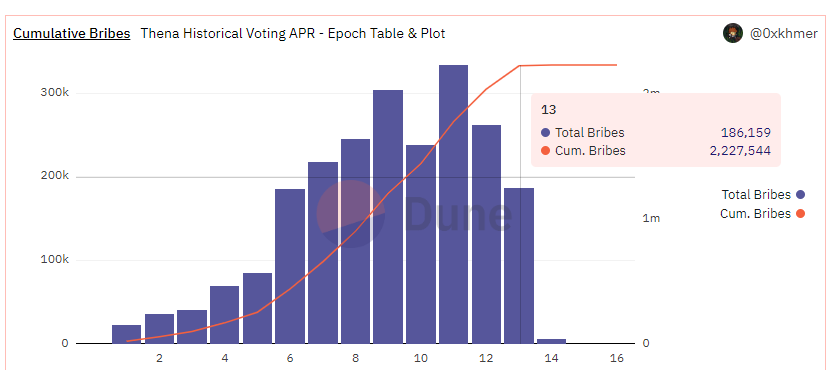
Data Sources:https://dune.com/0x khmer/thena
According to Thena’s official data, there are 146 active bribery pools (bribe amount > 0) in this period, 69 pools with a weekly bribe amount of more than $100, and 41 pools with a weekly bribe amount of more than $1,000.
Among the 10 projects with the highest bribery amount this week, the types include stable currency (Tangible), video streaming media (XCAD), LSD (Ankr, Pstake, Frax), derivatives and synthetic assets (Deus finance), Ponzi earth dog ( Libera), etc., are rich in types. Among the top 15 DeFi projects on BNBchain, apart from Thena itself, only Ankr (LSD), Radiant (loan) and Helio (stable currency) are currently purchasing liquidity in Thena.
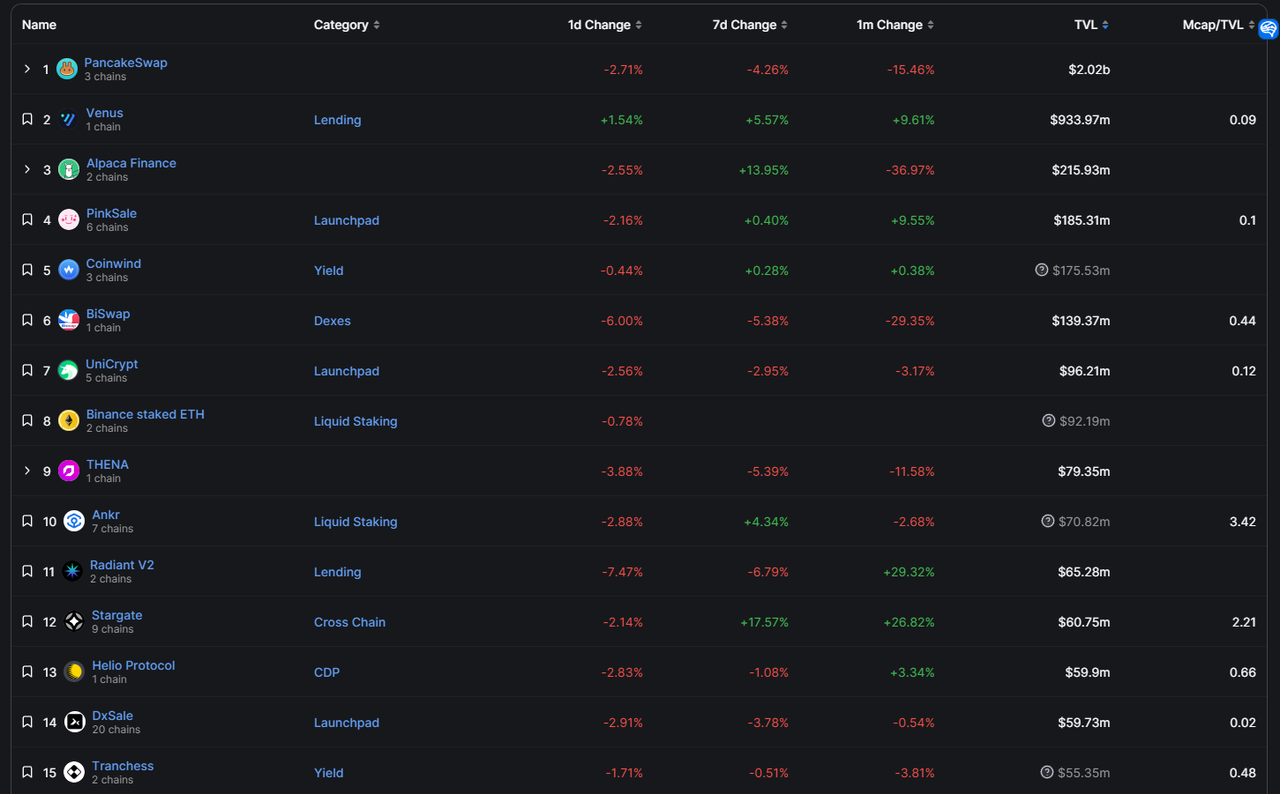
Excluding Thena’s competing projects Pancake and Biswap, among the remaining projects Venus, Alpaca, Chess, and Stargate have all been listed on Binance and have good liquidity.
Overall, Thena's liquidity procurement market business is developing well, and its customer base is relatively scattered. Although BNBchain's ecological vitality, number of high-quality projects, TVL and other indicators have stagnated and declined in the past one or two years, and it has been gradually overtaken by ecosystems such as Arbitrum, it still maintains a high number of active users and has attracted many new projects. This deployment, which is the main source of clients for Thena's liquidity market. However, BNBchain, as the "sidechain" attribute of Binance's centralized CEX, also limits its credit limit, resulting in too many projects and poor innovation; in addition, as the largest trading platform, Binance itself is also siphoning BNBchain's transaction volume .
d. Pledge ratio
Data Sources:

Data Sources:https://dune.com/0x khmer/thena
The main driving force for Thena's rising staking rate should come from a higher voting APR (Thena's average voting APR is 397%, and Velodrome has only two Pools higher than this voting APR), which is caused by two aspects Driven by:
The price of THE token itself is low (the valuation suppression caused by the slow development of BNBchain is one of the main reasons)
Liquidity purchasers bid fiercely and offered higher bribe fees
If the above conditions remain unchanged, Thena's pledge rate will have a great chance to continue its upward trend.
2.2.3 Summary
As the earliest ve(3, 3) project of BNBchain, Thena is currently operating very well, ranking third in Dex on BNBchain (both the first and second places are invested and supported by Binance). So far, it has done a few things right:
Improvements are made on the basis of Velodrome's practice, making good use of previous experience;
Adopting a building-block innovation approach and cooperating with other projects for development has greatly improved the speed of product iteration, such as cooperating with Algebra Protocol and Gamma to develop centralized liquidity, cooperating with MUON to introduce the recommendation rebate function, and cooperating with Open Ocean for transaction routing .
secondary title
2.3 Equalizer: ve( 3, 3) "single seedling" on Fantom
Equalizer is the Dex with the third highest TVL on Fantom, but it is also the project with the smallest TVL and market value among the ve(3, 3) projects that this research report focuses on. Fierce competitive environment.
2.3.1 Project introduction and difference mechanism
a. Mechanism design
Equalizer is currently only deployed on Fantom, and its mechanism is also inherited from Solidly. The differences in mechanism include:
The Rebase mechanism has been cancelled, and ve certificates are no longer allocated with emitted tokens
The upper limit of the ve token lockup period is 26 weeks, that is, half a year
Increased rates to 0.02% for sAMM pools and 0.2% for vAMM pools
No initial airdrop of ve token governance rights to other project parties
Among them, the design of Rebase is originally the most important item in the ve(3, 3) mechanism. AC believes that through Rebase, users' willingness to pledge can be improved. However, most of the more successful ve(3, 3) projects in the follow-up have greatly reduced the rebase ratio, because they all found that: too high rebase compensation for existing ve token holders will lead to governance rights Solidification, the cost and threshold for latecomers to obtain governance rights will become higher and higher, so they will completely give up joining. This situation will eventually lead to the rigidity of the system. By adjusting the ratio of Rebase rewards to total emissions for ve certificate holders, it is actually a trade-off between "incentivizing and introducing early users" and "leaving equal competition opportunities for latecomers".
As for whether to keep the Rebase mechanism and what the ratio should be, I think it should be decided according to the situation of the chain where the ve (3, 3) is located.
If we predict that the more stable the ecological pattern on a chain, the more likely the existing leading projects will remain ahead in the future, then the ve(3, 3) project should tend to lock these "customer agreements" early and give them enough ve governance rights and the right to purchase liquidity for free in the early stage through governance rights; if the competition situation in the chain is still chaotic, and the real "big customer agreement" has not yet emerged, then the ve (3, 3) project should avoid giving early ve Governance rights holders distribute too many benefits, but instead leave equal opportunities for later entrants to compete.
But the problem is: Most of the leading projects on the mainstream public chain have already been launched on the big exchanges, and have good liquidity, so their motivation to purchase liquidity on Dex will also weaken. In the long run, emerging projects will always be the main customers of liquidity procurement. For this reason, reducing or canceling Rebase has become the main choice for ve(3, 3 ) projects.
b. Team situation
Equalizer was founded by Blake Hooper, who has a marketing background in software and hosting services, and recorded most of the project's appearance videos. At present, there are 5 core members of the team, which is also a very capable personnel structure.
c. Memorabilia
2022.7 The project was launched and officially announced.
2022.11 Equalizer announced the launch time and airdrop plan. Users will start to receive airdrops on November 21.
2022.11 The Equalizer project was officially launched.
2022.12 TVL exceeded 10 million US dollars.
2023.3 Release the V2 version of Equalizer, the main update points are UI interaction (integrating Firebird transaction routing) and some mechanism repairs at the smart contract level.
On the whole, Equalizer does not have too many outstanding features at the product level. Compared with the other three ve(3, 3) projects, its delivery ability and innovation ability are relatively ordinary.
2.3.2 Business Situation
a. Liquidity (TVL) and corresponding liquidity purchase expenses
Data Sources:
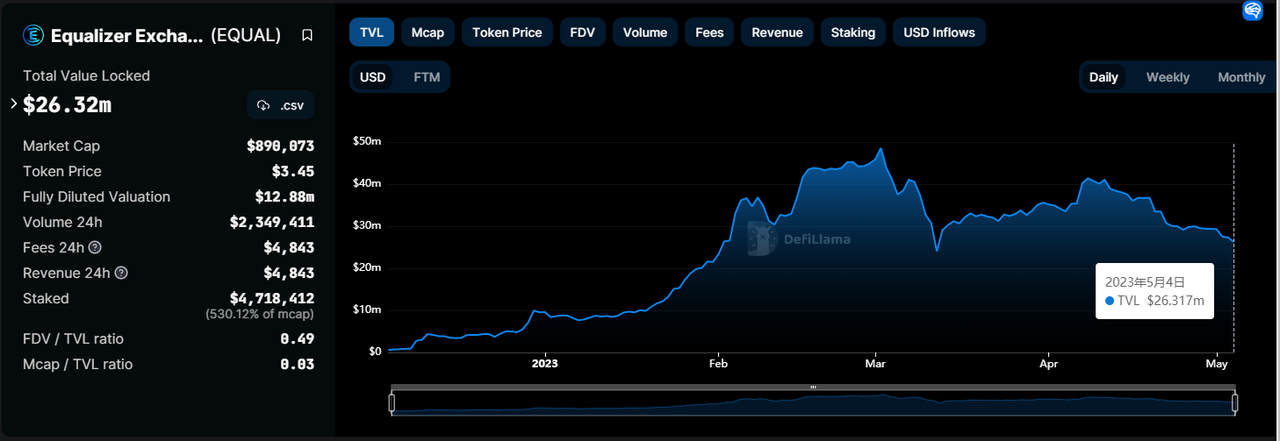
Data Sources:https://defillama.com/protocol/Equalizer
b. Transaction volume and transaction fees
According to Defillama data, the weekly trading volume of Equalizer in the past three months has fluctuated between 30 million and 120 million US dollars. However, since April, the trading volume has remained sluggish. The trading volume in the past two weeks has only been around 30 million. Around $30,000.


c. Bribe Amount and Item Quantity
The author has not found the previous bribe amount of Equalizer in the public information. According to the data of the latest period (epoch 25), there are currently 73 Pools open to bribery, of which 50 Pools have submitted bribes (some of them Including the team's own bribes), but the author was in the early stage of this epoch when he wrote the article, so the amount is not very high, and the data reference is not high.
However, judging from the screenshot of the official announcement of epoch 23, the total amount of bribes for the top 20 Pools in the week is about 95,544 US dollars. Based on this, it is estimated that the total amount of bribes for all pools in the week should be around 100,000 US dollars.


Among them, the top 10 bribery project types are mainly Defi projects, including revenue aggregators, derivatives, lending, etc., and there is also a domain name project.
d. Pledge ratio
Data Sources:

Data Sources:https://dune.com/0x khmer/equalizer-exchange
Data Sources:

Data Sources:https://ftm.guru/equalizer/analytics/
According to past data, the voting APR of Pools with large bribes is mainly in the range of 80% -150%.
2.3.3 Summary
Data Sources:
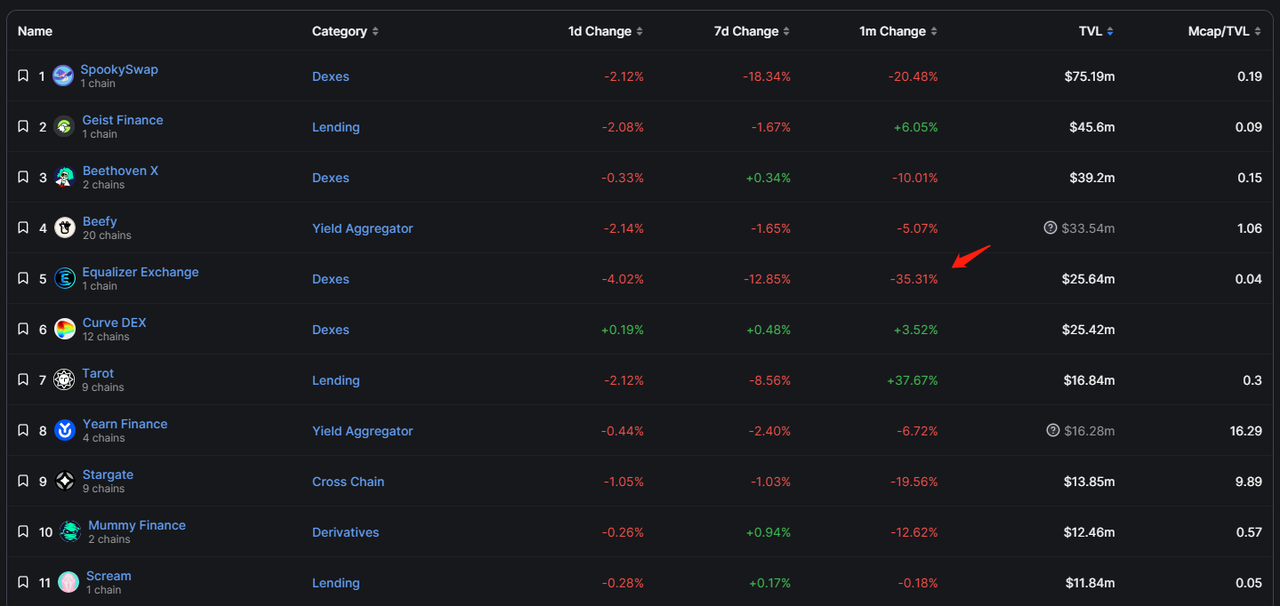
Data Sources:https://defillama.com/protocol/equalizer-exchange

Data Sources:https://defillama.com/protocol/equalizer-exchange? tokenPrice=true
secondary title
2.4 Chronos: ve( 3, 3) new force on Arbitrum
Chronos was just launched not long ago (April 26). Although it is not the first ve( 3, 3) project on Arbitrum, its initial business performance after launch is far more successful than previous attempts, and it also introduces A new mechanism for the traditional ve(3, 3) model problem is introduced. Although it is in the early stage of business development, the overall quality of the project is currently good, coupled with the good development momentum of Arbitrum, I think it is necessary to continue to pay attention.
2.4.1 Project introduction and difference mechanism
a. Mechanism design
Chronos deployed on Arbitrum, its mechanism design widely refers to Velodrome, Thena and Equalizer, the mechanism difference from the traditional ve( 3, 3) is reflected in:
Cancel the Rebase mechanism, ve users will no longer be allocated tokens (consistent with Equalizer)
The maximum time for ve lockup is 2 years (consistent with Velodrome)
NFT is used for fundraising in the early stage. After NFT is pledged, it can share 10-20% of the agreement's handling fee. There will also be a recommendation rebate mechanism in the future (consistent with Thena)
The concept of "staking time" is introduced for the LP certificate of the liquidity provider. After the user pledges the LP token again, he will obtain maNFT (Maturity-Adjusted NFT, that is, dynamic maturity NFT). MaNFT is used as a certificate for obtaining liquidity incentives. The higher the value, the stronger the bonus effect of getting incentives (up to 2 times)
vAMM rate is 0.2% (in line with Thena, Equalizer), sAMM rate is 0.01% (in line with Velodrome)
The most important innovation lies in the application of maNFT. The (3, 3 ) game design of the traditional ve( 3, 3) mechanism is mainly aimed at the pledge of tokens, but the retention of liquidity is still the responsibility of ve( 3, 3) Dex major problem. Using maNFT as an LP with a time-weighted attribute to distribute liquidity incentives will increase the willingness of LPs to retain for a long time and increase the "time value loss" of withdrawing liquidity. In addition, users of maNFT can also transfer liquidity through resale, and maNFT with a longer pledge time will naturally have a higher "time premium".
The introduction of maNFT has further upgraded the protocol's incentives for liquidity "quantity" to incentives for liquidity "quantity" + "retention". Of course, if the weight of the time element in the incentive distribution is too high, it will also cause new LPs to face the efficiency disadvantages of old LPs in liquidity mining, resulting in the inability to attract new liquidity. How to balance the two needs practice to prove.
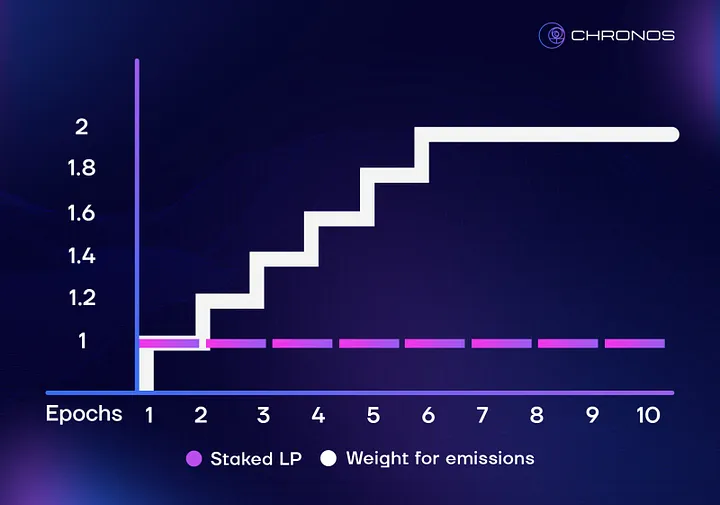
Effect of Chronos LP maturity on revenue acceleration, source: Chronos Medium
b. Team situation
The core team of Chronos is anonymous, and the officially announced nine core members only marked their job functions and did not provide more personal information. At present, the agreement has completed the audit of Certik.
c. Memorabilia
2023.3 Project launch, announced that the product will be released on Arbitrum.
On April 1, 2023, the details of NFT fundraising and rights and interests, as well as the list of cooperation agreements (which can obtain ve governance rights airdrops) will be released.
On April 14, 2023, the rules for the initial distribution of tokens and the details of the airdrop will be announced.
On April 20, 2023, specific launch rules and initial liquidity information were given.
On April 27, 2023, the project went live, Epcoh 0.
2.4.2 Business Situation
It should be noted that Chronos is still a new project that has been launched for less than two weeks when the author wrote this article, and its various business indicators and prices are in a state of violent fluctuations. Readers should take this factor into consideration when reading and referencing .
a. Liquidity (TVL) and corresponding liquidity purchase expenses
source:
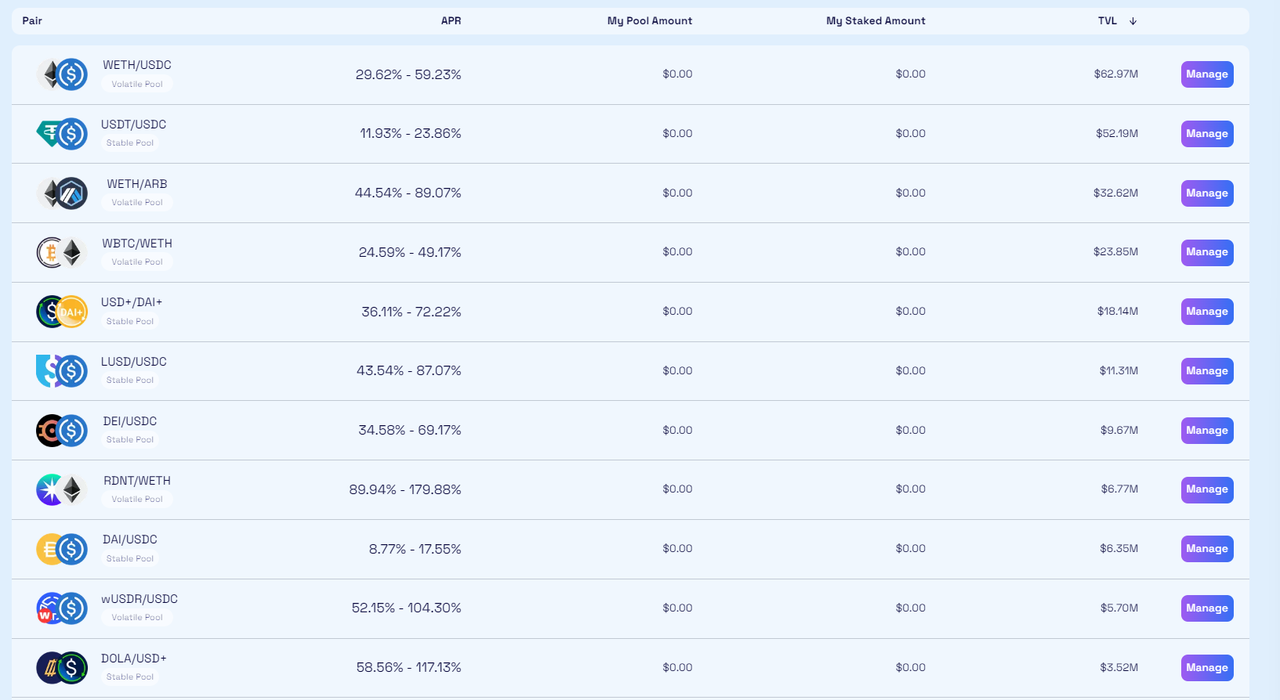
source:https://app.chronos.exchange/liquidity
At present, Chronos is at epcoh 1, and the weekly emission for liquidity purchase is 2,509,650 CHR (initial emission × 99% × 97.5%). Calculated at the current price of 1.18 $, this week Chronos’s The liquidity purchase fee is 1.18 × 2,509,650 = 2,961,387 $.
We also use TVL/liquidity procurement fee to get: 263,000,000/2,509,650 = 104.8, that is, the CHR incentive worth 1 $ can currently maintain a TVL of 104.8 $.
b. Transaction volume and transaction fees
Data Sources:
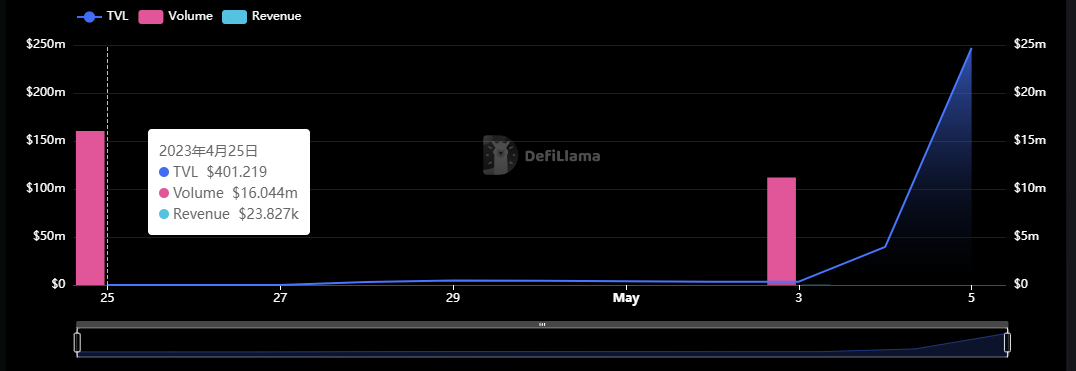
Data Sources:https://defillama.com/protocol/chronos
c. Bribe Amount and Item Quantity
image description
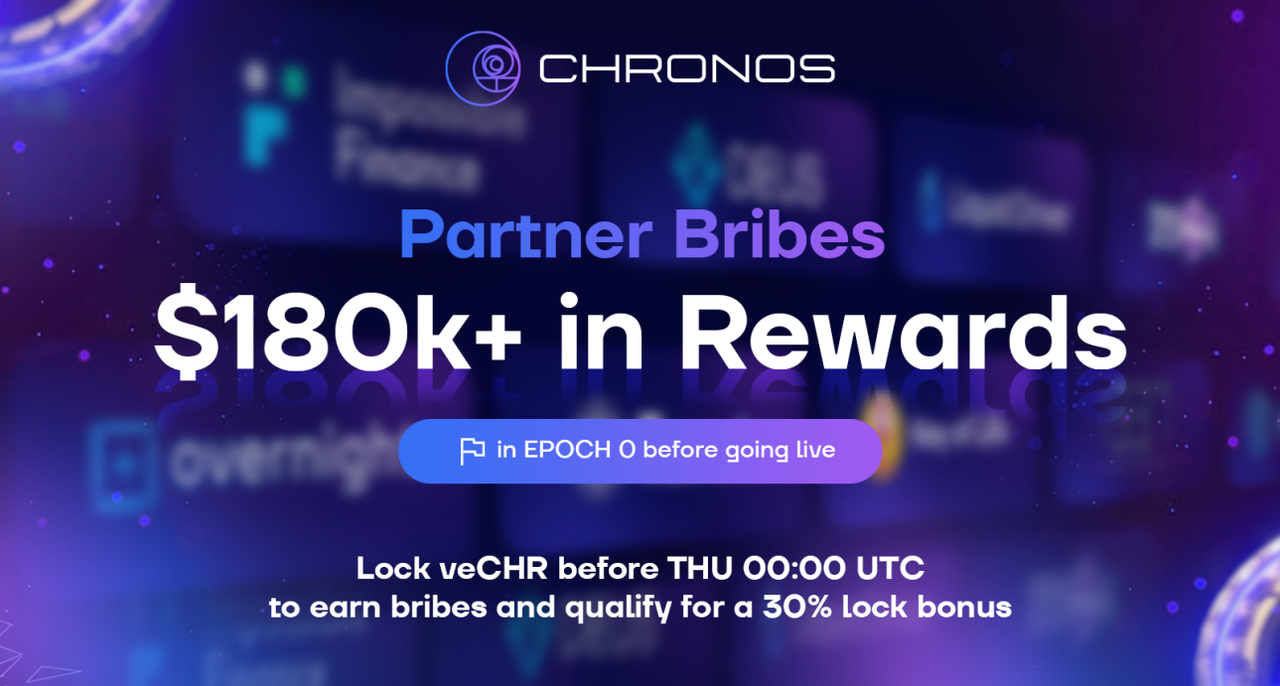
Source: Chronos Official DC
Among them, projects with a bribe amount above 5000 $ (according to the descending order of bribe amount) are: Overnight (stable currency), Yield Farming index (yield aggregation), GMD (yield aggregation), Deus (synthetic assets and derivatives), Radiant (loan) , Tangible (stable currency), etc.
In addition, before the official launch of Chronos, the veNFT airdrop cooperation agreement list released by the project party in advance is very detailed. In addition to specifying the positioning and allocation of cooperation projects, it also discusses the cooperation intention and value reached by the two parties at the business level. For exposition, it's impressive. As of now (epoch 1), there are 100 bribe pools established on Chronos.
according to
according to@impossiblefinanceData Sources:
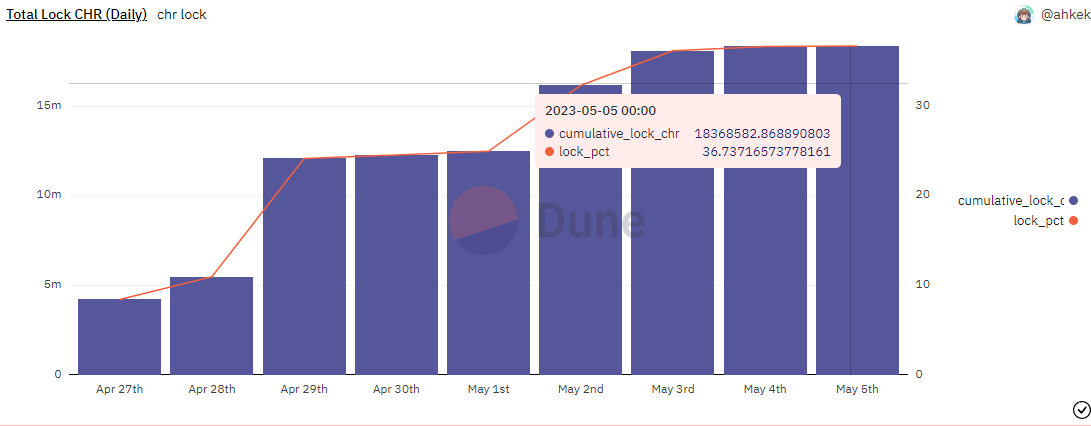
Data Sources:https://dune.com/impossiblefinance/chronos-finance
In contrast, Velodrome, Thena, and Equalizer’s other three ve(3, 3) projects mostly have a pledge rate between 60-80%, and the Chr lock-up rate still has a lot of room for improvement.
2.4.3 Summary
Chronos has further innovated on the basis of Velodrome, Thena and Equalizer, and introduced the time weight of LP as an important dimension of liquidity incentives, which is an active attempt to address the existing ve(3, 3) challenges. In addition, Chronos is on the ecologically prosperous Arbitrum public chain, which has a higher space for business development. However, Chrono is still in the epoch 1 stage, and its tokens are in a period of rapid inflation. At present, the weekly inflation rate of CHR relative to the initial total amount is about 5% and the overall willingness of users to lock positions is not high. The secondary market may remain in the short term. There is greater selling pressure.
3. Summary
secondary title
3.1 ve( 3,3) Compared with the ve project

PS:
1. The statistical and calculation time of the above data is 2023.5.5, and the data marked in yellow are estimated values.
2. The market value of the total supply is not FDV, but the market value of the total tokens minted so far (including those in circulation, pledged as ve certificates, and unlocked tokens).
3. The basic data sources used for calculation are mainly official disclosure and Defillama.
4. Bribe revenue for Curve and Balancer, using bribe data from Votium, Hiddenhand, and Votemarket.
*[Profit and loss] here refers to income (handling fee + bribe) - liquidity emission incentive
Statistics & tabulations: Mint Ventures
From the table above, we can see that due to the fierce competition on the Dex track, all veDEXs are currently at a loss stage only from the comparison of revenue and incentive fees (not considering the purchase of governance tokens by liquidity purchasers). However, due to the direct integration of the bribery module by ve(3, 3) type Dex, as well as looser liquidity procurement conditions (no governance vote is required to determine the authority to enter the Gauge, and a centralized application system is adopted), they have achieved "same liquidity under" higher bribe income.
secondary title
3.2 ve( 3,3) and the future of Dexs
From the perspective of business data performance, Velodrome has firmly established its TVL position on OP, Thena, as a latecomer, can rank in the forefront on the mature BNBchain, and Chronos has topped Arbitrum's TVL top three within two weeks of its launch. The superiority of the ve(3, 3) pattern in practice.
In the author's opinion, ve(3, 3), which was proposed by AC and carried forward by later generations, is a valuable exploration of Dex, and some experiments have proved to be quite effective, such as:
Integrate the liquidity procurement (bribery) module directly into Dex to improve the convenience of procurement and avoid the "taxation" of the tripartite voting platform
Emphasize the "TOB" attribute, pay attention to the incentives for liquidity purchasers (other project parties) (such as airdrop governance rights to potential customers), and significantly increase the income of bribery
Allocate Pool fees based on voting, and direct incentives to Pools that can create more fees
And some important mechanisms of ve( 3, 3) have been gradually falsified and eliminated in experiments, the most typical one is to ensure&nbs